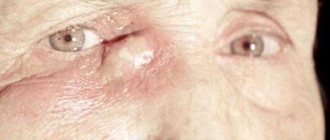Astigmatism - what is it - is a question that interests a large number of modern people. The reason is its prevalence and the need for timely treatment.
This article provides information regarding what astigmatism is, what types and degrees of the disease are present.
You can learn about the characteristic symptoms of the pathology, the reasons for its occurrence and the basic rules of treatment. So, first things first.
Astigmatism - what is it?
Every person understands perfectly well what conditions exist for ideal vision, for obtaining a clear, undistorted image. Light, in the process of passing through the natural cornea of the eye, must be focused in a certain place.
To be precise, this area is located in the central part of the retina. This focal point of light is medically called the macula.
If a person rapidly develops a phenomenon such as astigmatism, light passing through the cornea simply does not gather into a beam at the desired point, but stops simultaneously in several places. They can be located both in front of the retina and directly behind it.
As a result of such a deviation, a person sees highly blurred images in the world around them, which sometimes look completely shapeless.
What is the main reason this happens? The basis for this pathology is the abnormal development and disruption of the natural shape of the cornea. In the absence of injuries or problems, it looks like a regular hemisphere.
When light hits, the cornea immediately refracts it and automatically collects it on the macula. During the development of astigmatism, when this part of the eye has a completely incorrect appearance, light is refracted not only in different places, but also in different intensities. Based on this, a person develops several focuses at the same time.
Can people with astigmatism join the army?
Young people, whose turn has come to repay their debt to their homeland, are very often concerned with the question of whether eye astigmatism is an obstacle to serving in the army. It is impossible to answer this question unequivocally, since everything depends on the exact degree of impairment diagnosed in a particular conscript. As a rule, young people with a mild form of astigmatism fall under category B. However, there are some nuances here. Only vision from 2 to 4 diopters is taken into account. With such vision, a conscript is obliged to serve, but in certain troops.
If the degree of violation is weak, then such a young man is fit to serve in the army, but they have the right to call him fit only during military operations. But even here, not everything is so simple. A medical examination must be completed every three years. If during this time the medical board finds that the conscript’s visual functions have improved, he will receive category B and go to serve. Those young people whose vision is plus or minus 6 diopters and above will not be accepted into the army.
Main types and categories of disease
Astigmatism is a completely independent disease. Despite this, the problem very often manifests itself simultaneously with equally common phenomena such as farsightedness and the more common myopia.
At the same time, the pathology can be quite difficult to treat and completely simple. Based on these factors, experts divide pathology into the following categories:
- The simple form is hypermetropic. When it develops, a natural refraction of light is observed in a small area of the eye cornea, and a sign of farsightedness appears in a nearby area.
- Complicated hypermetropic. In a similar situation, farsightedness appears on parts of the cornea, but in varying degrees.
- Relatively simple myopic. With it, places on the cornea with natural light refraction and the manifestation of signs of myopia are combined.
- A more complex form of myopic pathology. This optimally combines myopia, which is distinct in severity, which differs depending on the areas on the eye cornea.
- The type of disease is mixed. This is the optimal combination of myopia in one area of the cornea, and in others there are signs of farsightedness.
The exact type and category of pathology can only be determined by an experienced specialist. At the same time, the doctor determines the axis of visual impairment.
For this purpose, the Tabo scale is used, where the measurement unit is ordinary angular degrees in the range from 0 to 180. Using it, the operating meridians of the functioning of the eye organ can be determined.
You need to know that pathology may vary according to the general indications of the examination prescribed. Among the main types are:
- Direct astigmatism, where the meridian has an enhanced angle of light refraction equal to approximately 90 degrees or located on a scale of 30 degrees vertically.
- The reverse form of astigmatism - here the meridian is characterized by a high refractive index and appears in a completely horizontal position along the original axis, as well as in a sector slightly more than 30 horizontally.
- Category of astigmatism with skewed axes. Here, the main meridians are marked on the main scale in the range from 30 to a full 50 degrees, and can also be marked in the area from 120 degrees to 150.
Depending on the characteristics of the identified disease, the doctor selects treatment. To smooth out the picture as much as possible, you will need to strictly follow all the recommendations and advice provided by your doctor.
Classification
Astigmatism is divided into several types.
According to the refraction of the main meridians or planes of the eye, three types are distinguished:
- straight - in this case the greatest refraction occurs in the vertical plane,
- reverse – greatest refraction in the horizontal plane,
- oblique.
Based on the type of refraction or degree of refraction of light rays, three types are also distinguished:
- simple - in one of the meridians of the eye the refraction is normal, in the other - myopic or hypermetropic,
- complex - in this case there is myopia or hypermetropia in both meridians,
- mixed - different meridians have different refraction.
If astigmatism is combined with myopia, it is called myopic; when combined with farsightedness, it is called hypermetropic astigmatism.
According to the degree of astigmatism, defined as the difference in refraction of the weak and strong meridians:
- mild degree - the refractive difference does not exceed three diopters,
- medium degree - the difference reaches six diopters,
- high degree - a difference in refraction of more than six diopters.
If the refractive error occurs in the cornea, astigmatism is called corneal, if in the lens - lenticular.
Levels of disease development
Along with the types of the problem described, doctors subdivide it according to changes in the structure of the ocular cornea. We are talking about the factor of how strongly a given element refracts rays in the meridians.
Against the background of this factor, three main degrees of development of visual impairment are distinguished:
- Weak. Here the deviations do not exceed 3 diopters. This degree is more common and can be quite successfully corrected by modern methods of influence. The simplest and fastest treatment option is laser eye correction.
- Average. A fairly serious deviation equal to 3-6 diopters. This form is not as common as it might seem. It will no longer be possible to correct it by wearing simple glasses. The disease at this stage is quite well corrected by the same laser correction and microsurgical interventions.
- Increased. Here there is a deviation exceeding 6 full diopters. This is a fairly high degree of complication, which is caused by a significant change in the cornea itself. This type is much more difficult to treat and in most situations, a combination of professional laser and general surgical correction is prescribed to correct vision.
Any degree of development of pathology can be corrected by a certain number of methods. The main thing is to see a doctor as quickly as possible and strictly follow his instructions.
Treatment
It is recommended to begin treatment for ocular astigmatism if the following conditions exist:
- loss of vision by more than one diopter,
- progression of vision impairment,
- persistent headaches, deterioration in general health.
Conservative and surgical methods are used for treatment. Treatment tactics depend on the severity of the eye disease:
- correction with contact lenses,
- correction with glasses,
- laser correction,
- microsurgical operation.
The earlier treatment for this disease is started, the better the result will be. For children under 18 years of age, surgical interventions are contraindicated; for any degree of astigmatism, only conservative therapy is prescribed.
Symptoms of astigmatic vision
Due to the fact that astigmatism seriously impairs visual acuity, a person automatically experiences such unpleasant consequences as increased eye fatigue, severe headaches, discomfort and painful pain.
The reason for such fatigue is based on the fact that the eyes, due to a certain blurring of the visibility of objects, are constantly straining, wanting to focus.
In addition to increased fatigue caused by serious stress, it is worth highlighting such characteristic symptoms as:
- Reduced overall visibility and visual acuity directed into the distance. This is a direct symptom of such unpleasant phenomena as farsightedness, the more common myopia, and the disease itself.
- Image distortion. This is a symptom characteristic exclusively of astigmatism. It can be noticed if the eye catches a completely flat surface. She just seems a lot changed.
- Feeling of irritation and long-term discomfort in the eyes. This symptom is a consequence of the load on the organs of vision. This factor manifests itself immediately in the process of focusing the gaze.
- A headache that occurs most often in the frontal area, usually just above the eyebrows. These unpleasant sensations are directly related to long-term stress. Many people suffer from such pain for quite a long time, drink a huge amount of painkillers, but in reality they just need to correct their vision.
- Difficulty focusing, for example, when reading texts. This sign is based on the fact that with the development of astigmatism, lines and paragraphs do not have an even structure; they are constantly curved, which is caused by a violation of the natural shape of the cornea.
- Slightly improved visibility and clarity during slight bends and turns. This sign is also based on a violation of the structure of the cornea.
- If you need to squint while focusing, this is also the main symptom of the described astigmatism.
Many of the listed symptoms are inherent not only to astigmatism, but to a large number of other visual pathologies.
If you have such troubles, you need to make an appointment with an experienced specialist as quickly as possible to diagnose the exact disease and to obtain the optimal treatment regimen.
Symptoms
Congenital pathology begins to manifest itself already in preschool age. The child begins to complain of poor and blurry vision, a feeling of “sand” in the eyes, and a headache. If you observe a child’s behavior, you can see the following signs:
- he often rubs his eyes
- when looking at objects, he tilts his head in different directions, squints,
- When reading, the child confuses letters with similar spellings and swaps them.
If left untreated, the disease can lead to the formation of strabismus.
Acquired astigmatism is manifested by nonspecific symptoms:
- At first, you are worried about increased eye fatigue,
- visual disturbances soon appear - blurred, unclear images,
- the need to strain the eyes leads to redness, burning, pain,
- double vision appears.
Gradual worsening of symptoms is associated with progression of astigmatism.
A characteristic symptom of this disease is accommodative asthenopia. This is a complex of symptoms that develop due to the need to constantly squint and strain your eyesight. It includes heaviness and pain in the eyes, headache. Symptoms worsen when trying to focus vision.
Main causes of pathology
There are only two types of this eye disorder, which differ in their causes. This problem can be congenital or acquired. Each type should be considered in as much detail as possible.
Congenital
In such a case, the problem arises due to the appearance of special related genes. It is with them that the special shape of the cornea is inherited. It is impossible to correct this state of affairs in this form.
You need to know that there is no such person who initially has a completely ideal cornea shape. Pathology, to one degree or another, is inherent in almost every person, and the deviation does not exceed 0.5 diopters.
This indicator does not appear, but becomes noticeable only when exceeded. Only in this case certain visual impairments appear. If they are detected in childhood, it is important to immediately correct them with correctly selected glasses.
If this requirement is ignored, the child may develop amblyopia or lazy eyes, and this problem is much more difficult to treat.
Acquired form
This type of pathology occurs after a certain impact on the cornea. It can be received at any time in life. There are several causes of acquired astigmatism:
- Trauma to the ocular cornea;
- Presence of a scar;
- Severe burn of the cornea or persistent conjunctivitis;
- Development of inflammation;
- Pathologies of the cornea - dystrophy and keratoconus;
- Previously performed operations on the sclera;
- Scars after interventions;
- Various diseases of the eyelids.
As can be seen from this list, there are quite a lot of reasons for such astigmatism. According to professionals, few people are immune from this problem.
Contact correction
In this case, astigmatic contact lenses are used. This correction method has several advantages over using glasses:
- the lens forms close contact with the cornea and ensures maximum effectiveness of vision correction,
- there is no lens shift forward or backward, resulting in no shift in focal length or change in accommodation,
- the lenses look more aesthetically pleasing than astigmatic glasses with cylindrical lenses.
Contact lenses are also selected individually, taking into account the same parameters as when selecting glasses. Use soft or hard materials.
It is important that the lens is firmly fixed in the eye.
Basic rules of therapy
So, astigmatism is a strong violation of the natural shape of the cornea. As a result of such a violation, the light is focused not as expected on the macula, but nearby.
Here we can conclude that in order to get rid of unpleasant astigmatism, you constantly need to “adjust” the focus of the eyes so that the light fluxes are focused exclusively in the central part of the retina.
To quickly and effectively correct astigmatism, modern experienced doctors use four types of effective correction.
Using glasses
This is an accessible and simple method of treatment for people. The technique is not ideal; if the normal vision deviates by more than 2 diopters, it will be impossible to achieve ideal vision.
Glasses should only be used for milder forms of astigmatism. The use of glasses can correct vision when the initial form of astigmatism develops, but will not correct it completely.
The selection of cylindrical optical products must be carried out by an experienced ophthalmologist. Without his advice, it is simply impossible to choose the optimal corrective lenses.
Before writing a prescription for suitable glasses, the doctor will definitely determine and resolve such important issues as:
- Myopia or developing senile farsightedness.
- Clarification of the directions of the main eye meridians.
- Category and degree of development of pathology.
Why are cylindrical glasses used to eliminate the disease, and not ordinary ones? They are characterized by the ability to refract light in a special way passing in a special perpendicular direction.
The effect that such glasses can provide makes it possible to effectively correct disorders directly in the meridian affected by the disease. The second meridian, which is not changed, is not affected by the points.
Sometimes doctors prescribe special spherical lenses to their patients. The main difference between this corrective device is their even refractive power in the meridians.
Glasses of this type are used quite rarely; they can have a positive effect only at the initial stage of the disease. Very often, doctors advise wearing such glasses as an addition to cylindrical lenses prescribed at the same time.
This treatment option is optimal for complex forms of the disorder, for example, mixed astigmatism.
Important! The main condition in the process of selecting spectacle lenses is their optimal refractive power. Glasses must clearly correspond to the established level of astigmatism.
Treatment with lenses
According to a large number of ophthalmologists and numerous people, the use of lenses is the most practical and effective. For this treatment, professionals use special modern toric lenses.
The resulting quality of overall vision when using them is much more significant than with conventional glasses.
Modern lenses form a single optical structure with the cornea. With the right approach, many compare this technique to laser correction.
Despite such effectiveness, the described devices are not suitable for many. The use of such lenses is much more expensive than laser correction, which is done only once. This option may only be suitable if surgery is contraindicated.
As for the benefits that are provided by using special corrective lenses, several main factors can be noted:
- The lenses are able to provide maximum effectiveness in vision correction. The reason for this performance is based on the fact that there is absolutely no distance between the cornea and the lens itself, while in the process of wearing glasses there is a distance of approximately 10 mm.
- The lenses are able to provide not only peripheral, but also central vision. Thanks to this, you can very well see objects that are located on the sides.
- Such devices can be worn in absolutely any weather. High-quality products do not fog up over time, and also do not attract attention.
For effective vision correction, you can use lenses made not only from soft polymers, but also from hard ones. The latter are usually made to order, since it is simply impossible to find them in the public domain.
For this reason, soft correctors are most often used. Among them it should be noted:
- Air Optix for Astigmatism;
- PremiO Toric;
- 1-Day Acuvue Moist for Astigmatism;
- Biofinity Toric.
In the process of creating lenses, companies pay quite a lot of attention to the method of fixing them on the eye cornea. Very often devices are produced with special ballast.
Its essence lies in the fact that a certain seal is formed in a certain area of the optical product.
As soon as it is influenced by a certain force of gravity, the edge is pulled back slightly, due to which the lens is always in the desired position.
If weighting is not necessary for vision correction, you can use lenses in which the edge of the lens is slightly cut off. This technique is quite effective, but is used infrequently, since due to such a cut, lenses are very often lost.
The most reliable and convenient weighting method is periballast. This is a more advanced technology than standard ballast.
In fact, these are relatively small thickenings in structure, which are created immediately on the upper and lower edges of the corrective device. This significantly increases the level of stability of the lens on the eye.
Important! Lenses for the treatment of astigmatism should be selected and prescribed exclusively by a qualified specialist. Self-medication is extremely unacceptable here.
Carrying out laser correction
According to a large number of specialists and patients, this option for eliminating astigmatism is the most effective. This is a completely safe method, the results of which last a lifetime. After the intervention, a person will no longer need contact lenses and glasses.
The main essence of this technique is the impact on the organ of vision using a special laser. The operation is performed by an experienced ophthalmologist who performs professional medical keratotomy. Essentially, this is the complete removal of the affected part of the cornea and a decrease in its refraction.
If a myopic form of astigmatism occurs, the doctor may prescribe a procedure such as thermokeratoplasty. This is surgical cauterization of the edges of the cornea to significantly increase its refractive power.
Both procedures are performed exclusively under light local anesthesia, since interventions of this type do not cause pain or other unpleasant sensations.
After surgery, a person may experience a slight burning sensation in the eye area. This sensation is caused by the gradual healing process of the cornea of the eye.
This is where all the unpleasant sensations end, but only if the manipulation was carried out in accordance with all established rules. It is very important to ensure that there are no contraindications before performing the procedure.
These include physiological severe damage to the retina, all forms of diabetes, as well as during pregnancy and breastfeeding.
Modern microsurgical operations for lens replacement
Among all the options listed above, this option is the most severe and radical. Similar interventions are used for the highest degrees of disease. Especially if there are contraindications to laser correction.
To correct vision, modern clinics use techniques such as completely replacing the transparent lens of the eye with a completely artificial lens or implanting a special actual lens into the inside of the eye.
This type of intervention is used only if pathology develops due to injury, if after a certain intervention the development or functioning of the lens is disrupted.
The essence of this correction option lies in the following actions:
- Detailed examination and determination of the type of astigmatism.
- Therapeutic intraocular, contact or intraocular lenses of toric or special spherical shape are manufactured.
- After testing, the products are implanted into the inside of the eye, in place of the damaged lens. This process is carried out under local anesthesia.
- After the intervention, the incision is very carefully sutured. After a couple of hours, the person can already go home.
Important! After a minimally invasive intervention, after surgical lens replacement, the patient needs to follow the most gentle regimen.
In order not to harm your eyes, you need to completely avoid working on a PC at first, it is advisable to minimize watching TV, and use special glasses with polarized lenses outdoors.
This method of optimal vision correction is characterized by a fairly large number of advantages. Despite this, a considerable number of patients refuse to undergo it. The reason is that many are afraid of various complications, the risk of which no doctor can rule out.
It can manifest itself in such unpleasant phenomena as increased lacrimation, such serious consequences as infection of a fresh wound, lacrimation and, in especially severe cases, intraocular bleeding.
When deciding how to effectively get rid of astigmatism, special attention should be paid to eye exercises. This is a fairly effective method of normalizing visual functions.
Despite such versatility and effectiveness, physical exercise should not be perceived as an ideal panacea. It is simply impossible to solve this form of visual impairment with gymnastics alone.
Properly structured and regular gymnastic exercises will allow you to very quickly and effectively, if not remove the initial form of astigmatism, but significantly alleviate its course.
The reason for this effectiveness is based on the fact that with such a violation, there is a strong tension and increased accommodation of the eye, and the overall refractive ability of the visual organ, in particular the lens, changes. It is due to this that it becomes difficult for him to look at objects.
This factor automatically leads to a significant increase in eye fatigue, and after a long stay on the PC, pain appears in the temples and eyes. So, what exercises should you do to significantly improve your natural vision?
Here are the most basic of them:
- You need to close your eyes as tightly as possible for about five seconds. This will seriously improve blood flow to the eyes and speed up the overall metabolism in this area.
- You need to go to the window and try to focus your vision on the glass. You need to find the point that is at the maximum distance. You need to look at it for 30 seconds. This part of the gymnastics effectively relaxes the muscles.
- At a slow pace, you need to rotate your eyes clockwise and back. This must be done for 20 seconds. This will allow you to activate your eye muscles as effectively as possible.
In the process of performing this very small set of exercises, the eye muscles quickly and very effectively rest and relax. Due to this, the necessary level of accommodation of the lens is ensured. At the same time, you can seriously improve your blood circulation and normalize metabolic processes.
Ophthalmologists strongly recommend that their many patients perform the presented gymnastics for the eye muscles at least three times throughout the day. If a person works at a PC, he needs to do such gymnastics at least once an hour.
Surgery
Surgery is the only way to radically cure astigmatism. However, even surgical treatment does not exclude the possibility of relapse of the disease after several years. The operation is prescribed for the following indications:
- ineffectiveness of conservative therapy and progressive deterioration of vision,
- patient intolerance to contact lenses,
- complex types of astigmatism.
Today, several types of surgical interventions are performed to cure astigmatism.
Surgical operations for astigmatism:
| Type of operation | Description | Flaws |
| Keratotomy | The essence of the operation is to apply incisions to the surface of the cornea using a microsurgical scalpel. This reduces the degree of refraction along one of the meridians, and vision is aligned | The healing process of the cornea is very long, relapses of the disease are frequent |
| Lens implantation | A corrective lens is inserted under the cornea. The mechanism of action is similar to the use of conventional contact lenses. Benefits of no eye irritation | Inconveniences when it is necessary to undergo surgery on the internal structures of the eye |
| Lens replacement | Taking into account the type and degree of astigmatism, an intraocular lens is made - an artificial lens. The lens is removed through an incision in the cornea and a lens is placed in its place. | The need for careful selection of lenses, complications may develop after surgery |
| Laser correction | The most effective and safe surgical intervention. A laser beam is used to remove part of the cornea or cauterize its edges to increase convexity | Infectious complications are extremely rare |
After lens replacement surgery, complications may develop:
- rupture of the lens capsule,
- displacement of the inserted artificial lens,
- infection of intraocular structures,
- vascular damage and development of intraocular bleeding,
- corneal injury.
Complications can be avoided by carefully following postoperative recommendations and regular monitoring by an ophthalmologist. After surgery, it is recommended for several weeks:
- avoid exposure to direct sunlight,
- do not overload your eyes with exposure to TV, books,
- do not visit swimming pools, saunas, baths.
Every week for a month you need to see an ophthalmologist. If you experience discomfort in the eye or signs of inflammation, consult a doctor.
There are contraindications for laser correction of astigmatism:
- pregnancy and breastfeeding period,
- decompensated diabetes mellitus,
- glaucoma or cataracts,
- inflammatory eye diseases,
- retinal pathology.
Astigmatism in children
You need to know that visual impairment such as astigmatism is often found in children. The cause of the disease can be caused by heredity, or it can also be acquired. Children usually have fairly high and complex degrees of impairment.
Quite often the problem is accompanied by problems such as:
- Albinism;
- Congenital retinitis pigmentosa;
- Fetal alcohol syndrome, which occurs if the mother regularly drank alcohol during pregnancy;
- Trauma to the eye, which leads to subluxation of the lens and rupture of the ligament of Zinn;
- The presence of pathologies in the jaw area, which automatically provokes deformation of the walls of the bony part of the orbit.
As can be seen from all of the above, there are quite a lot of reasons for the appearance and development of pathology. Diagnosis of astigmatism in children differs slightly from the examination carried out in adults.
Determining the disease includes procedures such as:
- Visometry.
- Biometrics.
- Skyscopy.
- Ophthalmoscopy.
- In some cases, doctors may prescribe an ultrasound of the eye organs.
Important! Children should always have their vision checked for astigmatism. Otherwise, you may face quite serious consequences.
If astigmatism is not detected in time, the consequences of its neglect can be quite disastrous. The child may develop amblyopia or lazy eye syndrome.
As this phenomenon develops in a child, the nerve in the visual organ will no longer take part in the process of fixing the picture. All this reduces the clarity of binocular vision, and this in turn can lead to the development of strabismus.
Diagnostics
To make a diagnosis, a comprehensive examination is required.
Methods for diagnosing astigmatism:
| Method | Characteristic |
| Visometry – assessment of visual acuity | It is carried out to determine myopic or hypermetropic astigmatism. First, uncorrected visual acuity is assessed. Then they put on glasses with replaceable lenses and select for each eye those diopters at which vision is as good as possible |
| Skiascopy and refractometry - determining the degree of light refractive error | Skiascopy, or shadow test, is performed first with spherical, then with special cylindrical lenses. Refractometry is a hardware diagnostic method. Before the procedure, the pupil is dilated with the help of medications. |
| Biomicroscopy | Examination of the anterior segment of the eye, including the cornea, anterior chamber and anterior surface of the lens. It is carried out to identify the possible cause of acquired astigmatism. Use a slit lamp for examination |
| Ophthalmoscopy | It is carried out to exclude pathology of the vitreous body and fundus. Performed using an ophthalmometer |
| Computed keratotomography | Using this method, the degenerative process in the cornea is revealed and the degree of corneal astigmatism is determined |
Only an ophthalmologist is involved in the diagnosis and interpretation of the results obtained.
Exercises to improve vision
This disease is characterized by increased eye strain. To relax them, it is useful to do gymnastics.
It is impossible to treat astigmatism in adults using these methods, but exercises help prevent its complications. Movements should be done smoothly, trying not to strain your eyes.
The exercises are as follows:
- Close your eyes and place your palms on them for half a minute.
- Close your eyes tightly for 3-6 seconds. Repeat 6-8 times.
- Blink quickly for 30 seconds, then look straight ahead for the same amount of time without blinking.
- Raise and lower your eyebrows. 20 times.
- Look left and right. A total of 20 movements.
- “Draw” the number “8” vertically, horizontally and diagonally with your eyes. Only 9 times.
- Look at the top left point, watch for a few seconds. Move to lower right, stop. Repeat on the other side. Only 10 times.
- Make 5 circular movements with your eyes in each direction.
- Look alternately at distant and close objects.
- Extend your hand, look at the tip of your finger for 5 seconds, look into the distance, repeat 10 times.
Prevention measures
Regardless of whether a disease is difficult or easy to treat, it is much easier to make efforts to prevent it. This rule also applies to eye diseases. First of all, the prevention of astigmatism consists of following the rules of personal hygiene, regular preventive examinations and performing gymnastic exercises for the eyes . If you work at a computer, then try to get into the habit of getting up from the monitor every hour and doing a little warm-up.
Prevention of astigmatism
Regular preventive examinations by an ophthalmologist will help identify possible eye problems at an early stage of their development, which will significantly speed up the treatment process. To prevent relapse of the disease, it is recommended to refrain from heavy physical activity. The fact is that intense training can provoke the progression of the disease. You can play sports only after permission from doctors.
Visit your ophthalmologist regularly
Folk remedies
When treating astigmatism, it would not be superfluous to use traditional medicine methods. It has been noted that it is useful to drink a decoction of blueberry leaves, since they are rich in vitamins A, E and C. To prepare it, you need to chop a tablespoon of leaves and add a glass of water. Boil all this for 3 minutes over low heat. Afterwards, leave it to brew. You need to drink a glass of it during each meal.
The beneficial properties of eyebright for improving vision have also long been known. To prepare the decoction you need 50 grams of dry herb, pour boiling water and leave for at least 4 hours. You need to drink a glass of the decoction three times a day. The treatment course lasts at least a month.
Restrictions in case of illness
With any eye disease, a person’s lifestyle changes, astigmatism is no exception. As pathology develops, the patient may be subject to a number of restrictions that must be observed.
Is sports allowed
Playing sports is useful, but you need to give up weightlifting (excessive muscle tension affects the condition of the fundus), team sports with a high degree of astigmatic component (poor orientation in space), contact sports (risk of getting a blow and injury to the eye).
With relatively high visual acuity, swimming, athletics, gymnastics, skiing and skating, badminton, tennis, and volleyball are allowed. Dancing and water sports are shown.
How is pregnancy progressing?
Pregnant women with vision pathologies are immediately taken under special control. The doctor will monitor the condition of the retina and the progression of myopic astigmatism. Possible changes in vision are associated with hormonal changes in the body and tissue swelling.
To eliminate the risk of complications, you should visit the ophthalmologist monthly after the 10th week of pregnancy, or more often if you have complaints of blurred vision, spots before your eyes, or headaches.
Advice! If you have dry eyes, you should replace the use of contact lenses with glasses.
Causes of the disease
- Congenital, as a result of abnormalities in the structure of the cornea and lens. The cause is most often uneven pressure of the eyelids, orbital bones and muscles on the eyeball, and deformation of the dental system.
- Acquired as a result of injuries, diseases, burns, inflammations. A number of injuries, including surgical interventions, leave behind scars on the cornea.
Reference. Astigmatism does not develop due to working with gadgets, watching TV or reading in poor lighting.
The role of psychosomatics
Psychologists associate changes in the visual apparatus with a person’s refusal to solve the problems of reality. Internal false beliefs that what I do not see does not exist, as a result, lead to a decrease in visual acuity. According to experts, the reluctance to see the world around oneself leads to myopia (I see well only close), and noticing changes in oneself leads to farsightedness (I see poorly near).
The reason for the development of astigmatism is considered to be a discrepancy between one’s own outlook on life and the opinions of others. The bifurcation of the visual picture into subjective sensations and objective facts leads to a vague real vision. Psychotherapists advise learning to hear other people and respect their point of view.
The disease in adults and in children - what is the difference between treatment
Laser correction is not performed until the age of eighteen. Children's astigmatism can only be corrected with glasses. It should be noted that the tissues of the eye in childhood are very flexible and elastic.
A child's ability to accommodate is higher than that of adults, which compensates for the irregular shape of the cornea or lens.
In addition, the visual organs are still developing. Therefore, there is hope to gradually cure childhood astigmatism through eye exercises, massage, etc. Astigmatism in a newborn often goes away on its own as the child grows older. Usually by the age of seven.
Glasses and lenses
For astigmatism, ophthalmologists recommend using special lenses for glasses.
Skolkovo talked about the possibility of complete restoration of vision
A new drug for the treatment of vision was presented at the innovation center. The medicine is not commercial and will not be advertised...
Read completely
These glasses have a special glass structure. In different areas of the lenses, the rays have different refractions. Thus, cylindrical lenses help focus all light rays on one object. In appearance, such glasses do not differ from ordinary glasses worn by people with low vision.
The only difference between them is their heavy weight. Such optical models must be purchased only in special optical stores. For astigmatism with complications, cylindrical lenses are combined with spherical ones, which transfer a single focus to the retina.
There is also a series of soft contact lenses with a shifted center of gravity. Lenses for vision correction for astigmatism are called toric. Such optics contribute to the refraction of rays, focusing them on one point. The lenses are breathable and cannot injure the cornea or cause complications in the disease.
Treatment of astigmatism using the Bates method
Astigmatism can be nearsighted, farsighted or combined. The vision correction technique, developed by ophthalmologist William Bates, is based on the ancient Indian system of healing. When performing eye exercises using the Bates method, you need to:
- Blink frequently and softly.
- Use weaker lenses and glasses than the doctor prescribed.
- Perform exercises designed specifically for hyperopic or myopic astigmatism.
- Turn your head to the sides with your eyes open and then with your eyes closed (at least 70 repetitions).
- Close your eyes and look at the sun every day for at least 5 minutes. The exercise should be done in the morning or evening with little solar activity.
- Do palming. To do this, place your palms on your eyes and imagine a rich black color for five minutes.
- Wear a bandage made of thick material at home for half an hour, alternately on the left and right eyes.
This treatment of astigmatism significantly improves the condition of the optical system of the eye.
Other useful exercises
By performing simple exercises, you can treat astigmatism at home. But at the same time, you need to remember that exercise cannot replace the main treatment prescribed by a doctor.
The most effective exercises to relieve eye strain are:
- drawing circles, letters and various figures in the air with the eyes;
- moving the gaze from the tip of the nose to a point on the horizon and back;
- rapid rotation of the eyes clockwise and counterclockwise;
- light tapping with fingertips on closed eyelids;
- concentration of gaze on distant objects for 10 seconds.
Each exercise should be performed for at least 1 minute, after which you should take a break and blink frequently.
Disease after laser correction
After laser correction, the patient receives full vision, since the light falls correctly on the retina. But this does not mean that the effect will be fully achieved immediately.
Firstly, the tissues of the eye are damaged and require some time to regenerate. Secondly, it is common for the human brain to adapt to working in new conditions for some time. And he will get used to the change in the shape of the cornea, just like with glasses.
After the operation, pain, inflammation, dry eyes, lacrimation and photophobia are observed. Restoration of vision does not occur immediately. In other cases, it will either improve or decrease throughout the day.
The recovery period after laser correction is up to 6 months. At this time, you must follow all doctor's instructions. If they are violated, the risk of postoperative complications increases.
Degrees of difficulty
The diagnosis of astigmatism involves determining not only the type of disease, but also the degree of its complexity. It is calculated by the difference between the refractive powers of the main meridians in diopters.
First degree
A weak degree is characterized by a difference of three diopters. Typically, a person feels rapid eye fatigue, a headache from visual strain, and by the end of the day, vision loses clarity, and double images are possible. This violation is the most common. It responds well to treatment.
You need to start fighting the disease as early as possible so as not to aggravate its complexity. At home, this can be preventive gymnastics or exercise therapy, selected by an ophthalmologist. If there is a concomitant diagnosis of hypermetropia or mild myopia, laser vision correction may be required, but in most cases the treatment consists of spectacle correction.
Second degree
The difference in refractive power along the meridians is from three to six diopters. It can no longer be corrected with glasses. Most often, surgical treatment methods are used, mainly laser correction.
The blurriness of the image depends on the magnitude of the difference in refractive power on the main meridians. Image distortion appears due to the apparent curvature of straight lines. The disease is constantly accompanied by headaches, a feeling of fatigue, and general discomfort.
Astigmatism to this degree easily determines the way you look at a written text - the lines dance, focusing and reading become very difficult.
Third degree
High degree astigmatism has a refractive power difference of more than six diopters. Accordingly, the degree of blurred vision increases even more.
It seems possible to get rid of astigmatism at this stage only with the help of a laser. The most progressive method today is the Lasik procedure. Its purpose is to cut off a thin layer of the cornea with a laser to give it the correct shape and smoothness. This procedure is also called keratomileusis. During the operation, a certain volume of the corneal layer is saved, ensuring the preservation of treatment results in the long term. High precision of the operation is ensured by a fully computerized excimer laser. It can change the profile of the cornea due to the inner layer without damaging the outer protective shell. As a result, the operation improves vision without the formation of sutures or scars.
Lasik operation sequence
However, even after Lasik there is a possibility of developing undesirable effects: keratoconus, dry eye syndrome, hyper or insufficient correction, corneal damage, fluctuations in visual acuity.
You can read more about treating astigmatism here.











